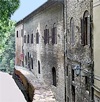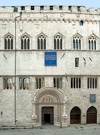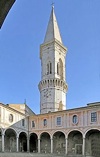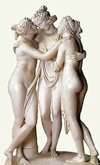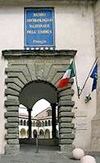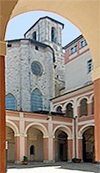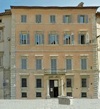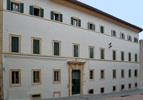Archeological Area under Piazza Cavallotti
A stretch of Roman road was excavated here in 1983-4.
Casa Moretti-Caselli
This interesting house belonged to Francesco Moretti (1833-1917), an outstanding expert in the technology of stained glass production and restoration. He adapted it for use as his workshop and studio. It passed down through another three generations of his family via:
-
✴his nephew Ludovico Caselli (1859-1922);
-
✴Ludovico's daughters Rosa (1896-1989) and Cecilia (1905-96);
-
✴their niece, Anna Matilde Falsinettini Forenza; and
-
✴her daughters, Elisabetta and Maddalena.
The last three still work and teach in the studio, which can be visited. It also contains an interesting collection of the family’s work.
Collection of Fondazione Cassa di Risparmio
This private art collection, which is housed in Palazzo Baldeschi Cennini, can be visited when the palace is open for exhibitions.
Galleria Nazionale dell’ Umbria
The gallery contains a fine collection that charts the development of art in Perugia and its surroundings from the 13th century.
Galleria Tesori d’ Arte
This gallery, which is housed in the upper floor rooms around the cloister of the Abbazia di San Pietro, exhibits much of the art collection that the Fondazione per l’ Istruzione Agraria inherited when it took over the abbey in 1890, in addition to works of art from the its church.
Ipogeo di San Manno
This Etruscan chamber tomb (late 3rd century BC) now forms the crypt of the church of San Manno, outside Perugia. A long inscription above the entrance to the left cell reveals that the tomb belonged to the brothers Avle and Larth Precu. It seems to have remained in use until the 1st century BC.
Museo dell’ Accademia di Belle Arti
The Museo dell’ Accademia di Belle Arti in the ex-Convento di San Francesco re-opened in 2012 after 15 years. (During this period, there had been a display of part of the collection at Palazzo della Penna - see below).
Museo Archeologico Nazionale dell' Umbria
The museum contains an extensive collection of items from ancient Perugia and other ancient Etruscan and Umbrian settlements, set out in the ex-convent of San Domenico.
Museo del Capitolo della Cattedrale di San Lorenzo
This museum, which is arranged in 26 rooms on two floors of the Palazzo dei Canonici, contains mostly works of art from the Duomo.
It is also possible to take a guided tour of the extensive archeological site under the palace.
Museo delle Porte e delle Mura Urbiche
The Museo delle Porte e delle Mura Urbiche, is above Porta Sant’ Angelo, offers magnificent views. As its name suggests, it is dedicated to the Etruscan and Medieval walls of Perugia and their gates. (The link is to an external website).
Palazzone Necropolis
This vast necropolis, which is above the Tiber, outside Perugia, was in use primarily in the Hellenistic period (4th - 1st centuries BC), but a small number of older hypogea have also been found here.
Links from the main page on the necropolis lead to pages on specific features of the site: the
Ipogeo dei Volumni and the
Antiquarium del Palazzone.
Palazzo Bourbon di Sorbello
This important “house museum” is located in Palazzo Bourbon di Sorbello (16th century), which is an interesting palace to visit in its own right. Visitors can see the family’s magnificent library and a permanent exhibition of its art collection.
Palazzo degli Oddi Marini-Clarelli (16th century)
This important “house museum” is located in Palazzo degli Oddi Marini-Clarelli (16th century), which was the ancestral home of the degli Oddi family. It has recently been completely restored.
Palazzo della Penna
Palazzo della Penna is an interesting palace to visit in its own right. It also contains:
-
✴three important art exhibitions:
-
•a large collection of works by Gerardo Dottori;
-
•the Martinelli Collection, a superb collection of Baroque art that belonged to the the Perugian art historian Valentino Martelli;
-
•six works that the German artist Joseph Beuys executed in Perugia in 1980; and
-
✴an excavated area of what seems to have been the Roman amphitheatre.





